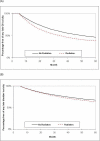Late GI and bladder toxicities after radiation for uterine cancer
- PMID: 21084108
- PMCID: PMC3026068
- DOI: 10.1016/j.ygyno.2010.10.017
Late GI and bladder toxicities after radiation for uterine cancer
Abstract
Objective: To determine the impact of radiation treatment for corpus uteri cancer on the development of late gastrointestinal (GI) and bladder toxicities in older women.
Methods: We used a linked database of the Surveillance, Epidemiology and End Results (SEER) program tumor registry records and Medicare claims to estimate the risk of late radiation toxicities in a population based sample of 23,591 women diagnosed with corpus uteri cancer from 1992 to 2005. Gastrointestinal (GI) and bladder diagnoses were included up to 60 months after diagnosis. Cox proportional hazard models were used to estimate risk of any late GI or bladder diagnosis with or without hospitalization, due to radiation.
Results: Women treated with radiation had an absolute increase in late GI toxicities of 7.7% and an absolute increase in late bladder toxicities of 3.9%. Most toxicities were not severe. Only 10% of irradiated women with a lower GI diagnosis and less than 1% of irradiated women with a bladder diagnosis, required hospitalization. In the multivariable analysis, advancing age, having chemotherapy, higher comorbidities and prior or early GI and bladder diagnoses were predictive of late toxicities among irradiated women.
Conclusions: Late GI toxicities are more common than previously reported. It is important to analyze late toxicities in population based samples of women with uterine cancer. The results of this and future analyses can be used to identify areas where development of "survivorship plans" will remind and encourage women to report symptoms related to potential toxicities.
Copyright © 2010 Elsevier Inc. All rights reserved.
Figures


Similar articles
-
The effect of postoperative beam, implant, and combination radiation therapy on GI and bladder toxicities in female Medicare beneficiaries with stage I uterine cancer.J Geriatr Oncol. 2012 Oct 1;3(4):344-350. doi: 10.1016/j.jgo.2012.06.005. Epub 2012 Jul 18. J Geriatr Oncol. 2012. PMID: 23138191 Free PMC article.
-
Late gastrointestinal toxicities following radiation therapy for prostate cancer.Eur Urol. 2011 Nov;60(5):908-16. doi: 10.1016/j.eururo.2011.05.052. Epub 2011 Jun 12. Eur Urol. 2011. PMID: 21684064 Free PMC article.
-
The Clinical Course of the Late Toxicity of Definitive Radiotherapy in Cervical Cancer.Medicina (Kaunas). 2024 Aug 21;60(8):1364. doi: 10.3390/medicina60081364. Medicina (Kaunas). 2024. PMID: 39202645 Free PMC article.
-
Pelvic Complications After Prostate Cancer Radiation Therapy and Their Management: An International Collaborative Narrative Review.Eur Urol. 2019 Mar;75(3):464-476. doi: 10.1016/j.eururo.2018.12.003. Epub 2018 Dec 17. Eur Urol. 2019. PMID: 30573316
-
Management of gastrointestinal perforation related to radiation.Int J Clin Oncol. 2020 Jun;25(6):1010-1015. doi: 10.1007/s10147-020-01662-5. Epub 2020 Apr 18. Int J Clin Oncol. 2020. PMID: 32303874 Review.
Cited by
-
Do comorbidity influences acute toxicity and outcome in elderly patients with endometrial cancer treated by adjuvant radiotherapy plus brachytherapy?Clin Transl Oncol. 2013 Aug;15(8):665-9. doi: 10.1007/s12094-012-0986-9. Epub 2013 Jan 29. Clin Transl Oncol. 2013. PMID: 23359175
-
Acute radiation impacts contractility of guinea-pig bladder strips affecting mucosal-detrusor interactions.PLoS One. 2018 Mar 7;13(3):e0193923. doi: 10.1371/journal.pone.0193923. eCollection 2018. PLoS One. 2018. PMID: 29513744 Free PMC article.
-
Gastrointestinal consequences of cancer treatment: evaluation of 10 years' experience at a tertiary UK centre.Frontline Gastroenterol. 2020 Aug 11;12(6):471-477. doi: 10.1136/flgastro-2020-101430. eCollection 2021. Frontline Gastroenterol. 2020. PMID: 34712464 Free PMC article.
-
Functional Changes of the Genitourinary and Gastrointestinal Systems before and after the Treatment of Endometrial Cancer-A Systematic Review.J Clin Med. 2021 Nov 27;10(23):5579. doi: 10.3390/jcm10235579. J Clin Med. 2021. PMID: 34884279 Free PMC article. Review.
-
Prevention and management of radiotherapy-related toxicities in gynecological malignancies. Position paper on behalf of AIRO (Italian Association of Radiotherapy and Clinical Oncology).Radiol Med. 2024 Sep;129(9):1329-1351. doi: 10.1007/s11547-024-01844-5. Epub 2024 Aug 28. Radiol Med. 2024. PMID: 39198369 Free PMC article.
References
-
- Jemal A, Siegel R, Ward E, Hao Y, Xu J, Thun MJ. Cancer statistics, 2009. CA Cancer J Clin. 2009;59:225–49. - PubMed
-
- SEER Cancer Statistics Review Horner MJ, Ries LAG, Krapcho M, Neyman N, Aminou R, Howlader N, et al., editors. National Cancer Institute . 2009. 1-17-2010.
-
- Jemal A, Clegg LX, Ward E, Ries LA, Wu X, Jamison PM, et al. Annual report to the nation on the status of cancer, 1975-2001, with a special feature regarding survival. Cancer. 2004;101:3–27. - PubMed
-
- Practice guidelines in Oncology - Uterine Neoplasms. National Comprehensive Cancer Network . 2008. 12-5-2009.
-
- Nag S, Erickson B, Parikh S, Gupta N, Varia M, Glasgow G. The American Brachytherapy Society recommendations for high-dose-rate brachytherapy for carcinoma of the endometrium. Int J Radiat Oncol Biol Phys. 2000;48:779–90. - PubMed
Publication types
MeSH terms
Grants and funding
LinkOut - more resources
Full Text Sources
Medical

